MIT Alumni Team Up for the Mars Curiosity Project
Jan 2, 2013

On August 5, 2012, Allen Chen ’00, SM ’02, the entry, descent, and landing operations lead for the Mars Science Laboratory (MSL) Curiosity rover, monitored telemetry through what he called “seven minutes of terror.” The complex landing sequence unfolded perfectly as engineers, mission managers, and VIPs waited on pins and needles. Click here to read the full story.

Senior flight software engineer Katie Weiss, SM ’03, PhD ’06, is pictured on landing night with her flight software operations team. Weiss underwent open brain surgery about two weeks before the landing but was back in mission control for the big event. She’s now heading up the design of JPL’s next-generation flight software architecture. Also a dedicated fitness instructor, Weiss calls NASA “one of the pinnacles of the best the human race can achieve, like the Olympics for athletes.”
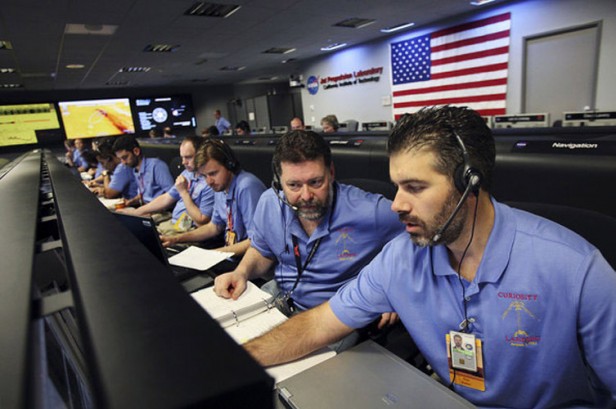
Propulsion engineer Todd Barber ’88, SM ’91 (second from right), says he owes his interest in aerospace to his grandmother, who handed him copies of National Geographic that covered the Voyager flybys of Jupiter and Saturn when he was in eighth grade. A composer who minored in music at MIT, he also channels his sense of exploration into visits to places around the United States where three or four states meet at a common point. Barber calls Curiosity’s successful landing—after flying 352 million miles—“an incredible rock-star moment” and “the greatest revenge-of-the-nerds fantasy.”

Lead flight director David Oh ’91, SM ’93, ScD ’97, calls landing night “the best reality TV ever.” Oh, his wife Bryn Oh ’95, and their three children became famous as the “Mars time family” for shifting their daily schedule for the month of August to Martian sols (days about 40 minutes longer than Earth days).
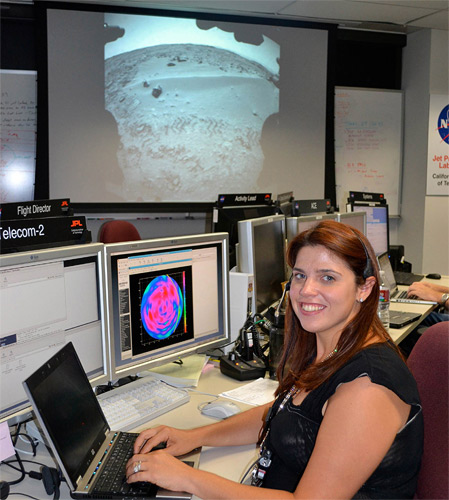
End-to-end communications lead Jennifer Maxwell ’01 ensures that communication flows between the rover, Mars-orbiting satellites, and Earth. She had a particularly nerve-racking time preparing for landing because the Odyssey orbiter had problems until a few days beforehand, which could have delayed confirmation of Curiosity’s touchdown for eight hours. Growing up on the Florida space coast, Maxwell always knew she wanted to work in the space program and was further inspired by her grandmother, a World War II pilot.

Several MIT graduates pose in JPL’s Mars Yard with an engineering model of Curiosity called the Vehicle System Testbed, used in the yard for mobility and robotic-arm testing. First row (L to R): Richard Kornfeld, PhD ’99 (MSL polo with patch); Grace Tan-Wang ’86; Jennifer Maxwell ’01; Erisa Hines, SM ’05; Louise Jandura ’84, SM ’86; Elizabeth Dewell ’02; Allen Chen ’00, SM ’02; Lauren DeFlores, PhD ’08; David Oh ’91, SM ’93, ScD ’97. Second row (L to R): Howard Eisen ’89, ’90, SM ’90; James Chase, SM ’02; Alexander Patrikalakis ’07, MNG ‘10; Andre Girerd, SM ’01; Bobak Ferdowsi, SM ’03; Scott McCloskey, SM ’07; Charles Whetsel ’89; Jeff Norris ’98, MNG ’99; Stephen Peters ’71; Charles Bell, SM ’76, PhD ’82; Noah Warner ’01, SM ’03, PhD ’07.
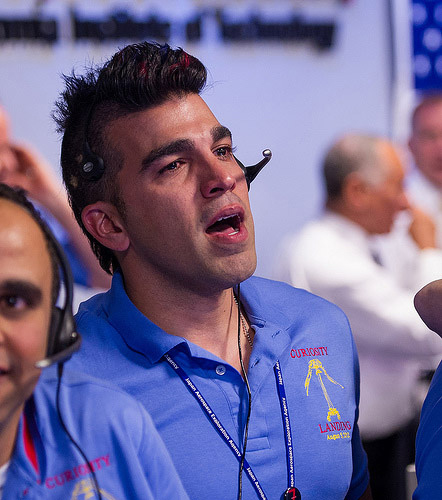
Flight director Bobak Ferdowsi, SM ’03, says his stomach was in knots on landing night. After investing nine years in the project, he shed “tears of joy, pride, and accomplishment” when the rover landed with nary a glitch. The closest analogy he could come up with was sending your kid off to college: “We’re still gonna keep in touch and talk,” he says, but now the rover is out on its own. In keeping with the NASA tradition of sporting something whimsical for mission milestones (think Spock ears, Viking helmets, and the iconic white vest worn by Gene Kranz during the Apollo missions), Ferdowsi adorned his Mohawk with stars and stripes for the occasion.

Attitude control system engineer Erisa Hines, SM ’05, who took a year off between graduating from MIT and joining JPL to investigate how she might use her aerospace degree for Christian ministry, worked on Curiosity’s course corrections and attitude turns during its 352-million-mile flight to Mars; now she’s working on surface mobility for the rover as it becomes more autonomous.

Tactical uplink lead Noah Warner ’01, SM ’03, PhD ’07, says that the challenge of landing “the heaviest thing ever on Mars” required “digging deep into toolkits … the kind of thing that makes you love your job, one of most beautiful things about JPL and MIT.” The camaraderie of the Curiosity team reminds him of the unified class in Course 16, where students did mini-projects in teams and then formed a 20- to 30-person team to develop a large piece of hardware. “These opportunities tested both technical acumen and interpersonal skills,” Warner says. “That’s just the beginning if you’re going to have a career in math and science.”
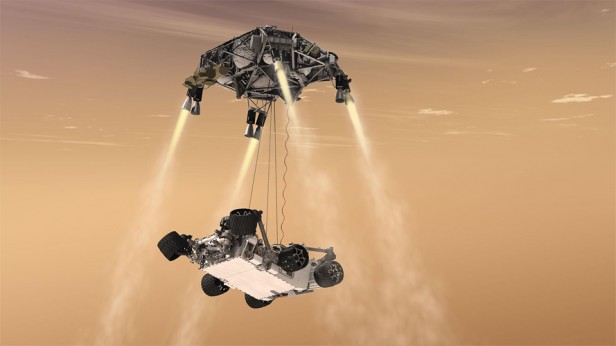
The MSL spacecraft was moving at 13,000 miles per hour when it entered the Martian atmosphere. “That’s the kinetic energy of several hundred formula one race cars zooming around at top speed,” says JPL’s Mars program manager Fuk Li, ’75, PhD ’79. The sky crane was a key element in Curiosity’s soft landing.
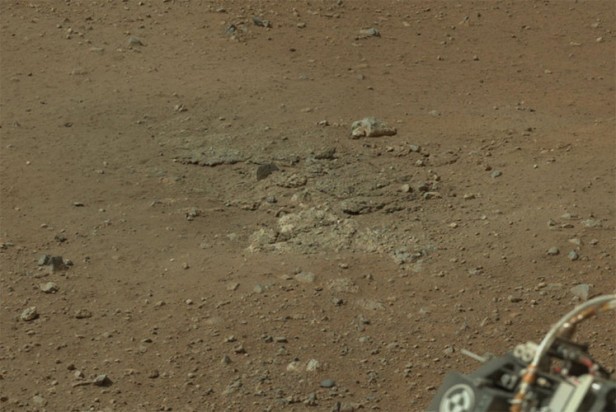
Since the JPL engineers couldn’t actually watch entry, descent, and landing, instead seeing only the data coming back from Mars, it wasn’t until the rover snapped photos like this one that they saw proof the landing had happened as expected, says attitude control system engineer Erisa Hines, SM ’05. This photo shows where the hovering descent-stage engines blew out a chunk of surface dust.
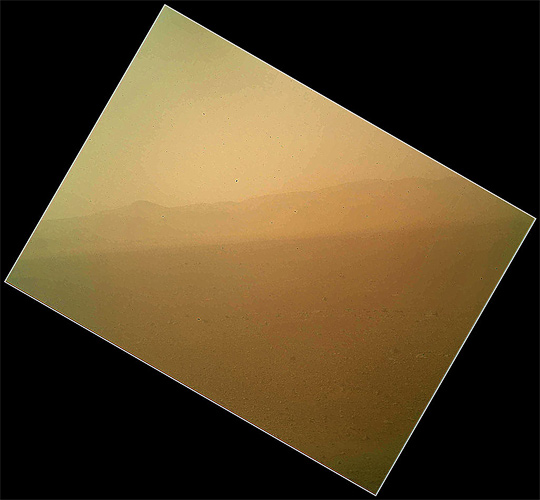
Curiosity’s first color photo from the surface of Mars shows the north wall and rim of Gale Crater, in which the rover landed. This photo was taken on the day after landing, with the robotic arm still stowed.
Author
From our advertisers
- In association with IntelGetting smart about the future of AI
- Autonomous driving: Safety first
- Produced in association with IBMOptimizing the engineering life cycle requires digital transformation